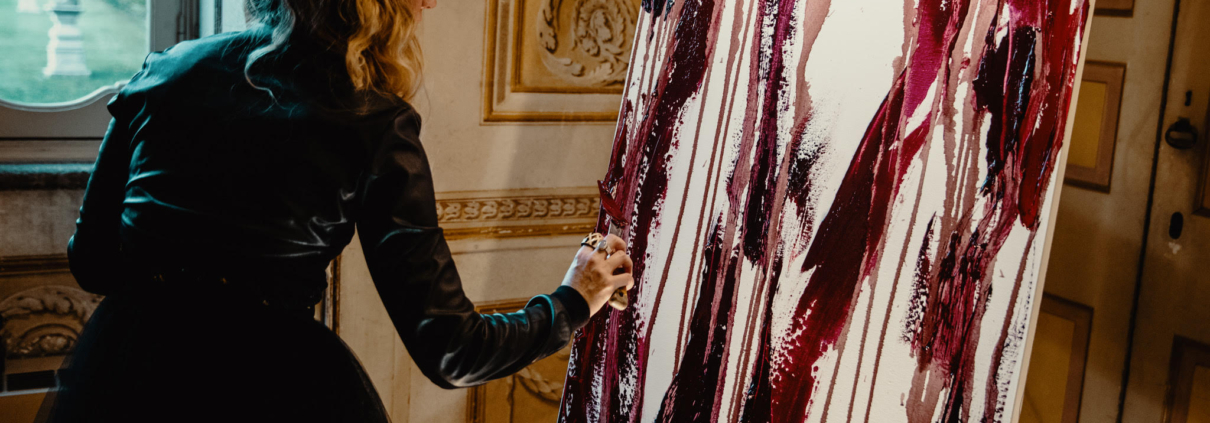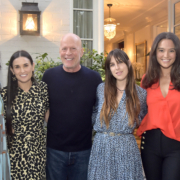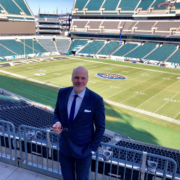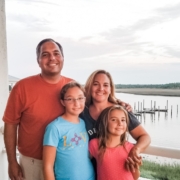Painting with taste
Most people sip wine and attempt to describe what they taste with words and phrases such as jammy, earthy, tart, even cat’s pee.
Artist Penelope Moore expresses what she tastes differently. In paintings. With brushes and sculpting wedges. Using oil paint. In many cases in front of a live audience at a fabulous gala or fundraiser for a charity.
Moore, 44, doesn’t think up these paintings on the fly. She relies on an instantaneous interpretation of her sense of taste. Because she has synesthesia, she experiences more than one sense simultaneously, and can reflect her sense of taste through her sense of sight. Essentially (but not literally), she paints with her taste buds, and she’s done so for the better part of the last eight years.
The result of this sensory mashup is what Moore herself refers to as “abstract expressions of taste.”
Red wines yield paintings that are a kaleidoscope of reds and blues and sometimes greens. White wines yield works that are yellow, orange, and maybe some red. Bubbles and pink wines can be gold, pink, even purple (depending on the types of grapes).
“When I paint, I can taste the colors that I squeeze from the tube and mix on my palette,” she said. “My oil paints are like a spice rack; when I paint it feels like I am cooking. My paintings are abstract expressions of taste, capturing flavor onto canvas. This mixing of the senses experience is what I have discovered to be synesthesia.”
Each of Moore’s pieces is fine art. If she is doing the painting at a fundraiser, the finished product is auctioned off with all proceeds benefiting the host charity. If she’s doing the painting in her studio (or on commission), the finished product sells for anywhere from $5,000 and up, depending on the size.
Today, Moore’s paintings can be found in dozens of winery tasting rooms across California Wine Country, as well as in her small gallery/studio in downtown Napa.
“I see and feel taste as an experience and bring it to life as art,” she said.
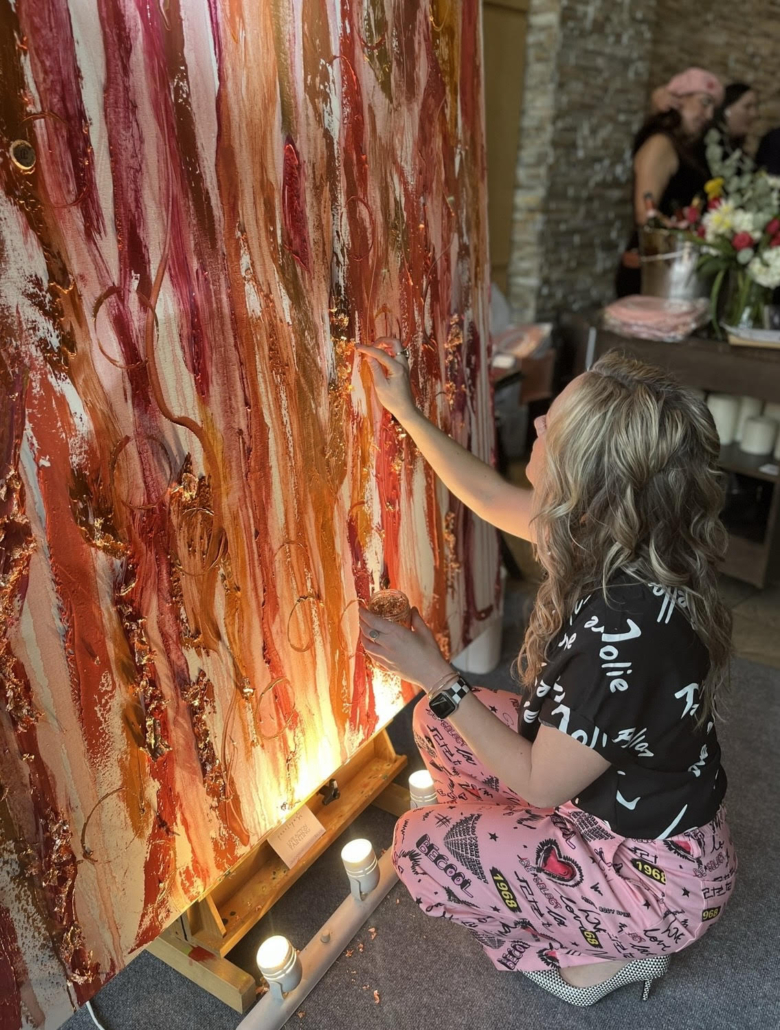
Unique experience with senses
Every synesthete’s experience with synesthesia is different. Moore’s manifests in four key ways: taste and smell turn into color and sight, while hearing and sight turn into taste. Seeing color also often triggers taste and smell. Often this results in something beautiful; paintings that are quite literally dripping with color and appear three-dimensional because of the chunky paint Moore applies to the canvas.
Sometimes, however, abstract expressionism fueled by Moore’s unique brand of synesthesia can present quite an obstacle for the artist to overcome.
Moore explained: “Sometimes, let’s say when I am painting a Chardonnay and I mix the wrong yellow, I can taste and even smell it, like mustard. Sometimes I mix a particular darker tone of yellow and all that I can taste and smell is mustard, like I am literally standing in a baseball park; encompassed. Mustard does not belong in Chardonnay. In order to emotionally proceed, I literally have to remove and clear the color completely off of my palette before mixing a new yellow flavor with a more accurate aroma. Even when I think about that particular color, I can taste it and depending on what I am doing in the moment, it can be repulsive and disruptive.”
Moore, who often shares original work on her Instagram, added that she also sees shapes in taste.
“For example, a Sauvignon Blanc, if I only had a white piece of paper and a sharpie, I would identify it by drawing a broken star pattern almost like starbursts and chards of glass, mimicking the persistent bursts of high key, bright acidity,” she said. “Chardonnay is [longer and more] lyrical with curvy fluid lines. Rosé on the other hand, is more of the shape of the leaves of a succulent: round and long in body but with pointed sharp tips; because of the pillowy floral notes juxtaposed with the zing of the pointy acid finish.”
Understanding these particulars of her synesthesia, Moore said she is most interested in exploring immersive sensory experiences and understanding how they create lasting memory impressions.
Often her exhibits are curated alongside culinary pairings where guests experience art and taste together with each painting as they move through the exhibit. In this sense, she basically asks guests to “taste” the art. Moore noted that she is interested in exploring the science behind synesthesia through a fusion of creative mediums, and seeks to find like-minded creatives, companies, and supporters to collaborate with.
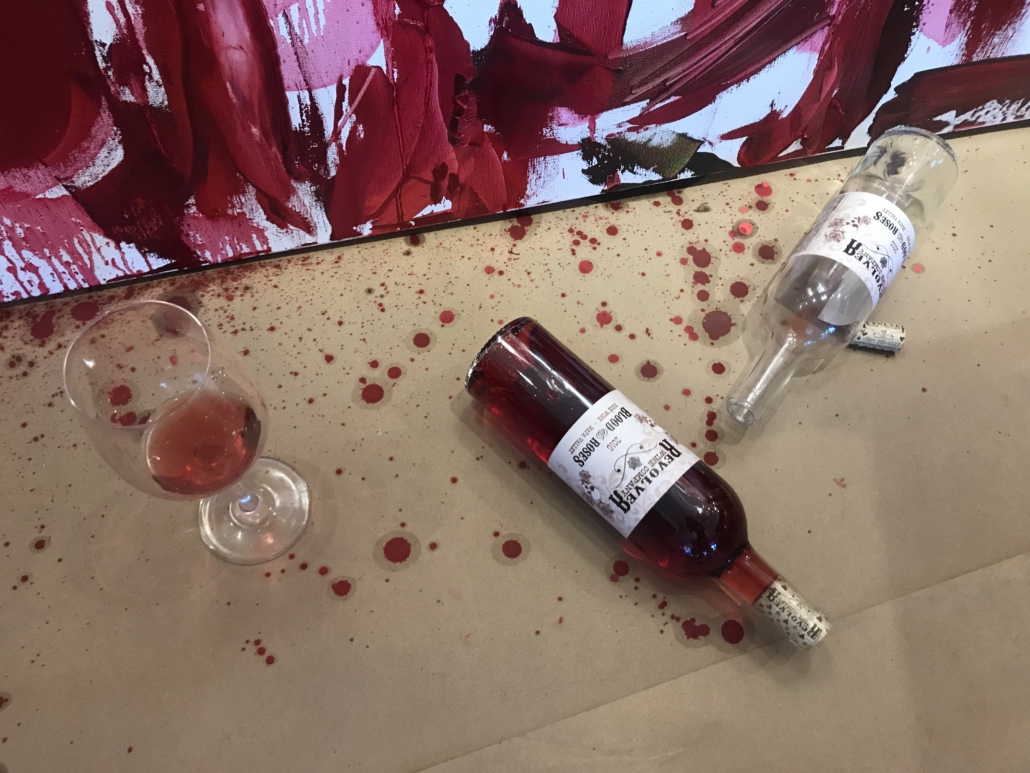
An exciting adventure
Moore received her BFA in fine art painting from the Academy of Art University in San Francisco in 2004. She has known she could paint what she tasted since then, but has only known what to call it since 2015.
Her synesthesia awakening occurred during a seemingly innocuous meal with some new work friends. Over the course of normal conversation, she described her ability to express her sense of taste through her artwork, and one of the friends said, “It sounds like you have synesthesia.” Moore had never heard the term until that moment. She whipped out her phone and looked it up.
Suddenly, everything made sense.
“It always just felt normal, so I never really thought too much about it,” she said, noting that she’s never had a formal diagnosis. “Being able to know what to call it was huge.”
This moment was a huge transition point for Moore; after it, she leaned almost exclusively into the art of taste inspired by things she drank or ate. Some of her early projects comprised smaller pieces that she called “Amuse Bouche” paintings. In marketing these pieces, she would often photograph them on top of place settings, since they looked good enough for others to eat. This led to a professor at the Culinary Institute of America having students replicate the paintings as desserts—a treat for both Moore and guests alike.
Moore moved into larger canvases and live painting performances—mostly with wine, but sometimes she with cocktails, too. The largest pieces usually would take her about three hours to complete during a live event, while her smaller pieces would take about an hour.
All told, Moore spent roughly 10 years living in the Napa Valley, interspersed with three years in Italy. Recently, she moved to Florida for a change of scene and the chance to explore new ways to express her senses through art. (She calls Miami a “flavor playground.”) She has kept her gallery in the Napa Valley for now, and is utilizing the space to share her work and highlight the work of others.
Looking to the future, Moore said she is excited to paint mojitos and some of the other Latin flavors that are prevalent in Florida.
Another of Moore’s goals for the future is to paint a corked wine, or a wine that is faulty. She’s never done it and said she imagines it would be a beautiful painting with lots of browns and complex colors she doesn’t typically include in her work.
“Browns and swampy colors would still make a great painting,” she said. “It’s all about expression.”
This article is a companion piece to this feature about synesthesia.
Photo credit for the top photo: Rawspektiv Media, Italy. All other photos courtesy of Penelope Moore.

